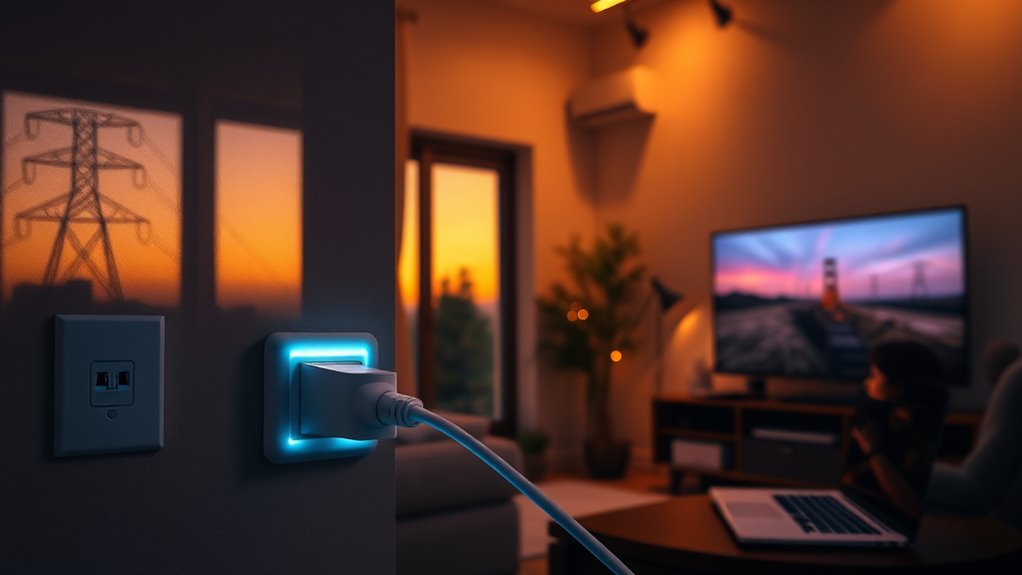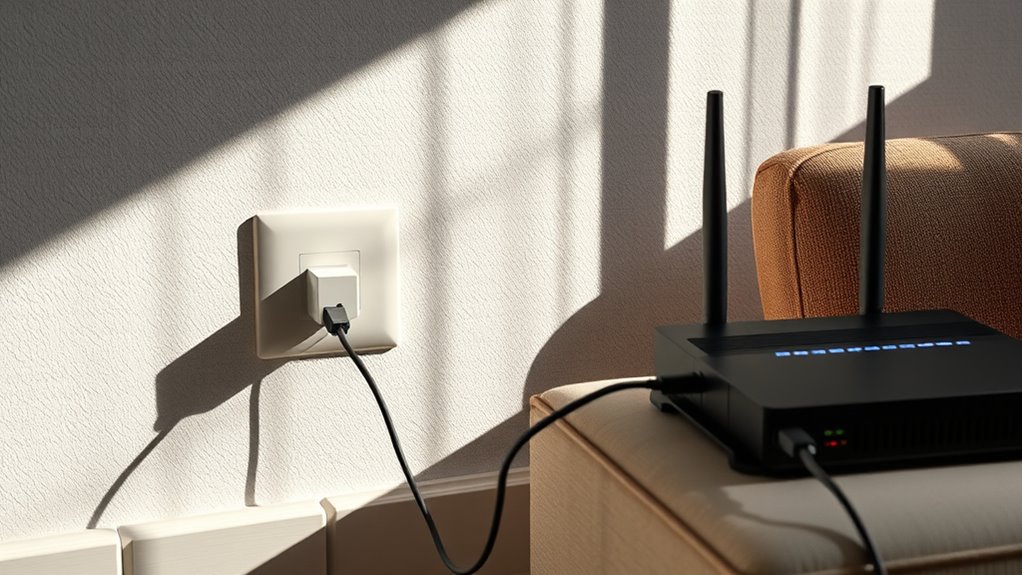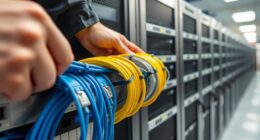Powerline networking uses your home’s existing electrical wiring to extend your internet connection. You plug adapters into outlets near your devices and connect them to your router via Ethernet. These adapters transmit encrypted high-frequency signals over wiring, providing stable, fast internet without adding new cables. While setup is simple and reliable, electrical noise and wiring quality can affect performance. If you want to understand how to optimize it, there’s more to explore below.
Key Takeaways
- Powerline networking uses existing electrical wiring to extend internet connections within a home through adapters plugged into outlets.
- It communicates by transmitting encrypted high-frequency signals over power lines, avoiding interference from typical home devices.
- Proper setup involves connecting adapters to outlets on the same circuit and minimizing electrical noise for optimal performance.
- It offers a simple, stable, and discreet alternative to Wi-Fi or Ethernet, ideal for streaming, gaming, and multi-room connectivity.
- Performance can vary depending on wiring quality, circuit design, and household interference, making it suitable for specific home environments.
Understanding Powerline Networking Basics

Powerline networking allows you to use your existing electrical wiring to transfer data, making it a convenient solution for extending your internet connection. However, some powerline myths can lead to confusion or false expectations. For example, many believe that powerline adapters work flawlessly in all homes, but troubleshooting issues like weak signals or interference can arise due to wiring age or electrical noise. Understanding the basics helps you identify potential problems early. Powerline networks rely on your home’s electrical system, so factors like circuit configuration and distance matter. Additionally, cybersecurity vulnerabilities such as interference or malicious attacks can impact performance, emphasizing the importance of understanding these risks. By debunking myths and knowing common troubleshooting steps, you can optimize your setup and ensure reliable performance. Recognizing these fundamental concepts is key to making the most of powerline networking’s benefits. Being aware of home electrical wiring and its condition can further improve your network stability and security. For instance, the wiring quality and age can significantly influence the effectiveness of your powerline connections. Moreover, considering the suction power of your networking equipment can help in achieving better data transmission rates, especially in complex electrical environments.
Components of a Powerline Network

A typical powerline network consists of several essential components that work together to deliver internet connectivity over your home’s electrical wiring. The main parts include powerline adapters, which plug into outlets and transmit data using powerline standards like HomePlug AV2. These standards guarantee compatibility and peak performance. Your electrical wiring acts as the network’s backbone, carrying signals across rooms. To set up, you need at least two adapters: one connected to your router and another to your device. Keep in mind that older or complex wiring might affect speed and stability. The table below summarizes the key components:
| Component | Function | Key Consideration |
|---|---|---|
| Powerline Adapter | Transmits data over electrical wiring | Compatibility with powerline standards |
| Electrical Wiring | Carries signals between adapters | Age and wiring complexity influence performance |
| Power Outlet | Connects adapters to the electrical system | Ensure proper grounding |
Additionally, the overall safety of powerline networking depends on proper installation and adherence to electrical standards. Understanding the performance factors can help optimize your setup and ensure reliable connectivity.
How Powerline Adapters Communicate

When your powerline adapters communicate, they send data as high-frequency signals over your home’s electrical wiring. These signals are encrypted to protect your information from potential eavesdroppers. Understanding how this transmission works helps you appreciate both the efficiency and security of your network connection. Additionally, privacy policies ensure users are informed about how their data, including transmitted signals, is protected and managed. The encryption process employs advanced algorithms to safeguard your data during transmission, further reinforcing the importance of secure data transmission. This technology often relies on high-frequency signals that are imperceptible to the human senses, ensuring seamless connectivity without interference. Moreover, awareness of electrical wiring quality can impact the stability and speed of your powerline network.
Signal Transmission Process
Ever wondered how data travels seamlessly through your electrical wiring? It all starts with signal modulation, where your powerline adapters convert digital data into high-frequency signals that ride over your electrical cables. These signals are carefully encoded to distinguish them from regular electricity, ensuring efficient transmission. The process relies heavily on wall organization systems, which can help reduce electrical noise and interference, improving overall signal quality. However, power line noise—from appliances or electrical interference—can disrupt this process, causing data loss or slower speeds. To combat this, adapters use advanced filtering and error correction techniques to maintain a stable connection. When you send data, your adapter modulates it into a high-frequency signal, which then travels along the wiring, overcoming noise and interference. At the receiving end, the signal is demodulated back into usable digital data, allowing your devices to communicate smoothly. Proper placement of the adapters and avoiding high-noise areas can also significantly improve signal quality and overall performance.
Encryption and Security
How do powerline adapters keep your data secure as it travels through your electrical wiring? They use encryption protocols similar to wireless encryption, ensuring your data remains private. When your powerline network is active, the adapters generate encryption keys that scramble your data, making it unreadable to anyone trying to intercept it. This process safeguards your data privacy by preventing unauthorized access or eavesdropping. Many adapters automatically establish secure connections using high-level encryption standards like AES. These security features help protect sensitive information, whether you’re streaming, gaming, or working remotely. Additionally, understanding eye patch benefits can remind you of the importance of protecting delicate skin from environmental factors, much like how encryption protects your data. Proper encryption protocols help ensure that your data remains confidential during transmission, reducing the risk of security breaches. While powerline networks aren’t completely immune to security threats, proper encryption considerably reduces the risk, giving you peace of mind that your data stays private and secure during transmission.
Setting Up a Powerline Network

Setting up a powerline network is a straightforward process that transforms your existing electrical wiring into a reliable internet connection. First, check powerline compatibility by ensuring your devices support the same standard, like HomePlug AV2. Plug your adapter into a nearby wall outlet and connect it to your router with an Ethernet cable. Then, plug the second adapter into an outlet near your device and connect it as well. If you encounter powerline troubleshooting issues, make sure the outlets aren’t on different circuits or controlled by different switches, as this can disrupt the connection. Avoid using power strips or surge protectors, which can interfere with signals. Once connected, you should have a stable, high-speed network extending throughout your home. Understanding electrical wiring and how it impacts signal transfer can help optimize your setup.
Advantages of Using Powerline Networking

Powerline networking offers an easy setup process, so you can get your network running quickly without complex wiring. You’ll also enjoy reliable connection stability, ensuring smooth streaming and online gaming. These advantages make powerline networking a convenient choice for your home or office. Additionally, understanding vibrational energy can help you optimize your network environment for better performance and stability. Properly managing electromagnetic interference can further enhance the effectiveness of your powerline network. Being aware of powerline signal quality can assist in maintaining a strong and consistent connection throughout your space. Incorporating automation in business intelligence can help monitor and adjust your network for optimal performance and security.
Easy Setup Process
One of the biggest advantages of using powerline networking is its simple setup process. You don’t need to run Ethernet cables or tinker with complex configurations. Just plug a powerline adapter into a power outlet near your router, connect it via Ethernet, then plug the second adapter where you need the connection. The process is quick and straightforward, making it ideal for non-technical users. To keep your powerline aesthetics tidy, choose adapters with sleek designs that blend into your space. If you encounter issues, troubleshooting tips like ensuring adapters are on the same circuit or resetting them can help. Overall, this hassle-free setup saves time and minimizes frustration, making powerline networking an easy choice for expanding your home network effortlessly. Additionally, understanding 16PF traits can help in optimizing your device placement for better performance.
Reliable Connection Stability
Because it utilizes your existing electrical wiring, powerline networking often provides a more stable and consistent connection than wireless options, especially in environments with potential interference. Unlike Wi-Fi, which can be disrupted by interference sources like appliances or thick walls, powerline offers reliable connection stability. You won’t have to worry about frequent dropouts or signal loss. This dependable performance makes it ideal for streaming, gaming, or working from home. Additionally, the remote work environment benefits from such stable connections, enhancing overall productivity.
Limitations and Potential Interferences

While powerline networking offers convenient internet access through existing electrical wiring, it isn’t without its limitations. Electrical interference from devices like microwaves or cordless phones can disrupt signals, reducing speed and stability. Distance limitations also affect performance; the farther your adapter is from the main power source, the weaker the connection becomes. Additionally, older wiring or poorly maintained circuits can cause issues. Cookies and other factors can also impact the quality of your connection. Here are key concerns to keep in mind:
- Electrical interference from household appliances
- Signal degradation over long distances
- Compatibility with older or damaged wiring
- Variability based on electrical circuit design, which can be influenced by your home’s electrical infrastructure to a significant degree.
Ideal Scenarios for Powerline Deployment

Powerline networking works best in environments where electrical wiring is relatively modern and stable, minimizing issues caused by interference or outdated circuits. If your home has recent wiring, you’ll experience fewer connectivity problems and more reliable performance. This setup is ideal for integrating home automation devices, allowing seamless control of smart lights, thermostats, and security systems without extra wiring. Additionally, powerline networking can boost energy efficiency by enabling centralized management of connected devices, reducing unnecessary power consumption. Homes with multiple floors or thick walls benefit from powerline’s ability to extend network coverage without complex installations. Overall, if your electrical system is solid and well-maintained, powerline networking offers a practical, efficient solution for smart home setups and energy-conscious living.
Comparing Powerline to Other Networking Options

When choosing a networking method, it’s important to compare powerline technology with alternatives like Wi-Fi and Ethernet. Powerline offers a discreet setup that doesn’t clutter your space with extra cables, enhancing powerline aesthetics. It generally consumes less power than some Wi-Fi extenders, making it energy-efficient. Here are key differences:
- Speed: Ethernet usually provides faster, more reliable connections than powerline or Wi-Fi.
- Convenience: Wi-Fi offers wireless mobility, while powerline requires minimal setup through existing wiring.
- Power Consumption: Powerline devices typically use less energy than Wi-Fi extenders or routers.
- Interference & Stability: Ethernet is the most stable, powerline can be affected by electrical noise, and Wi-Fi may face interference from other devices.
Choosing depends on your space, needs, and aesthetic preferences.
Frequently Asked Questions
Can Powerline Networks Work Across Different Electrical Circuits?
Powerline networks generally don’t work well across different electrical circuits because electrical noise and circuit isolation interfere with signal transmission. When you try to extend a network between separate circuits, electrical noise from appliances or other devices can disrupt data flow. Additionally, circuit isolation prevents the signals from crossing boundaries, so your connection may weaken or fail altogether. To improve performance, keep devices on the same circuit whenever possible.
What Security Features Do Powerline Adapters Offer?
Powerline adapters offer security features like encryption protocols and device authentication to safeguard your network. They encrypt data transmitted over the electrical wiring, making it hard for outsiders to intercept. Additionally, device authentication ensures only trusted devices connect, preventing unauthorized access. You should enable these features and keep firmware up-to-date to maximize security, giving you peace of mind that your network stays protected from potential threats.
How Does Wiring Age Affect Powerline Performance?
Wiring age substantially impacts powerline performance, with older wiring often reducing speeds by up to 50%. As wiring ages, it may require regular maintenance to prevent issues, and electrical noise from outdated circuits can cause interference. This noise disrupts data transmission, making your connection slower or unstable. So, if your wiring hasn’t been maintained or upgraded, expect diminished performance, and consider wiring maintenance or upgrades for better powerline networking.
Can Powerline Networks Coexist With Smart Home Devices?
Yes, you can use powerline networks alongside smart home devices. To guarantee smooth operation, focus on interference mitigation; avoid noisy appliances and electrical interference sources. Check device compatibility, as some smart devices may have trouble connecting or maintaining stability on powerline networks. By choosing compatible devices and minimizing electrical interference, you can seamlessly integrate powerline networking with your smart home setup for reliable performance.
What Is the Maximum Data Transfer Rate for Powerline Networks?
Imagine your powerlines as a busy highway, carrying data at lightning-fast speeds. The maximum data transfer rate for powerline networks varies, typically reaching up to 1 Gbps in ideal conditions. However, real-world bandwidth capabilities often settle around 200-500 Mbps due to interference and wiring quality. These data transfer limits ensure you can stream, game, and browse smoothly, but keep in mind that actual speeds depend on your home’s electrical environment.
Conclusion
Now that you understand how powerline networking works, you can decide if it’s the right fit for your needs. It’s a handy solution when running Ethernet cables isn’t practical, offering a simple plug-and-play setup. Just remember, every tool has its quirks—powerline networks aren’t perfect for every situation. When used appropriately, they can bridge the gap nicely, proving that sometimes, the best solution is right under your nose.









